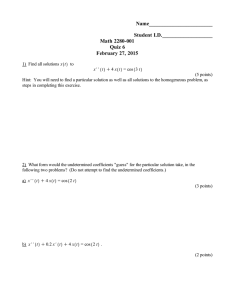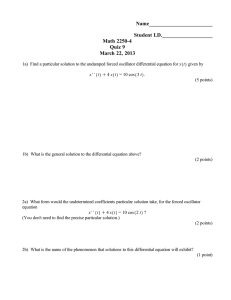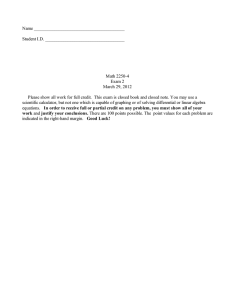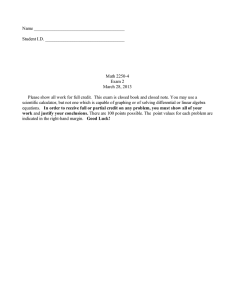Math 2250-4 Fri Mar 8
advertisement
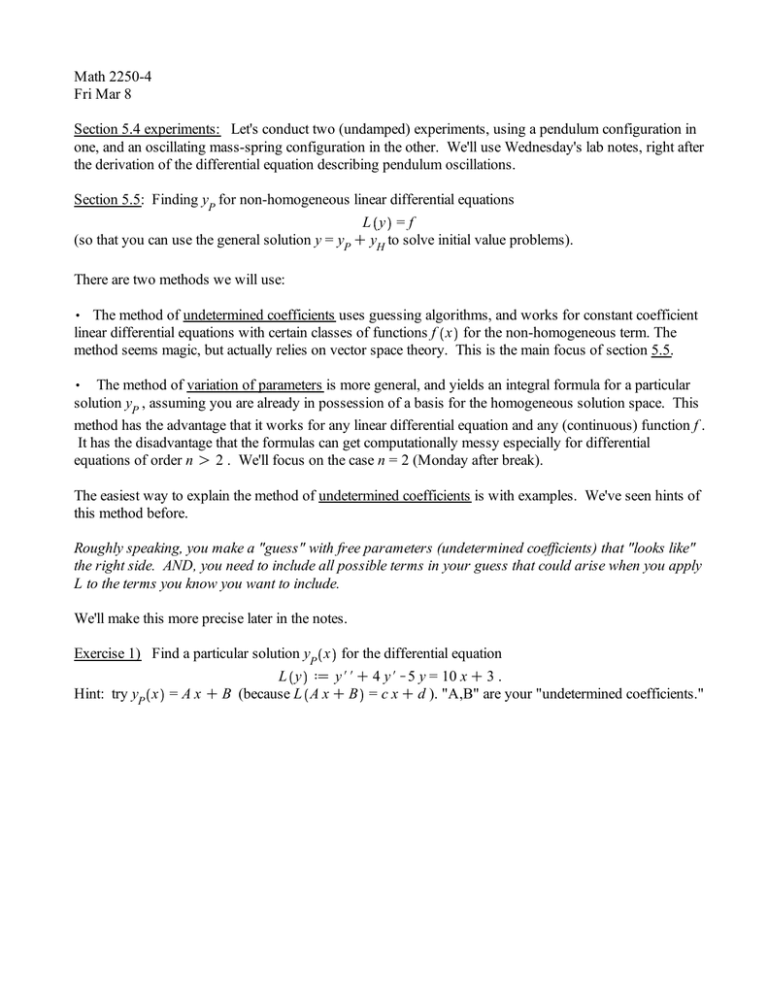
Math 2250-4 Fri Mar 8 Section 5.4 experiments: Let's conduct two (undamped) experiments, using a pendulum configuration in one, and an oscillating mass-spring configuration in the other. We'll use Wednesday's lab notes, right after the derivation of the differential equation describing pendulum oscillations. Section 5.5: Finding yP for non-homogeneous linear differential equations L y =f (so that you can use the general solution y = yP C yH to solve initial value problems). There are two methods we will use: , The method of undetermined coefficients uses guessing algorithms, and works for constant coefficient linear differential equations with certain classes of functions f x for the non-homogeneous term. The method seems magic, but actually relies on vector space theory. This is the main focus of section 5.5. , The method of variation of parameters is more general, and yields an integral formula for a particular solution yP , assuming you are already in possession of a basis for the homogeneous solution space. This method has the advantage that it works for any linear differential equation and any (continuous) function f . It has the disadvantage that the formulas can get computationally messy especially for differential equations of order n O 2 . We'll focus on the case n = 2 (Monday after break). The easiest way to explain the method of undetermined coefficients is with examples. We've seen hints of this method before. Roughly speaking, you make a "guess" with free parameters (undetermined coefficients) that "looks like" the right side. AND, you need to include all possible terms in your guess that could arise when you apply L to the terms you know you want to include. We'll make this more precise later in the notes. Exercise 1) Find a particular solution yP x for the differential equation L y d y##C 4 y#K5 y = 10 x C 3 . Hint: try yP x = A x C B (because L A x C B = c x C d ). "A,B" are your "undetermined coefficients." Exercise 2) Use your work in 1 and your expertise with homogeneous linear differential equations to find the general solution to y##C 4 y#K5 y = 10 x C 3 Exercise 3) Find a particular solution to L y = y##C 4 y#K5 y = 14 e2 x . Hint: try yP = C e2 x since L C e2 x = d e2 x . "C " is your "undetermined coefficient". Exercise 4a) Use superposition and your work from the previous exercises to find the general solution to L y = y##C 4 y#K5 y = 14 e2 x K 20 x K 6 . 4b) Solve (or at least set up the problem to solve) the initial value problem y##C 4 y#K5 y = 14 e2 x K 20 x K 6 y 0 =4 y# 0 =K4 . 4c) Check your answer with technology. Exercise 5) Find a particular solution to L y d y##C 4 y#K5 y = 2 cos 3 x . Hint: To solve L y = f we hope that f is in some finite dimensional subspace V that is preserved by L, i.e. L : V/V . , In Exercise 1 V = span 1, x and so we guessed yP = A C B x. , In Exercise 3 V = span e2 x and so we guessed yP = C e2 x. , What's the smallest subspace V we can take in the current exercise? Can you see why V = span cos 3 x and a guess of yP = C cos 3 x won't work? All of the previous exercises relied on: Method of undetermined coefficients (base case): If you wish to find a particular solution yP , i.e. L yP = f and the non-homogeneous term f is in a finite dimensional subspace V with the property that L preserves V, and if the only function g 2 V for which L g = 0 is g = 0, then there is always a unique yP 2 V with L yP = f . proof: This is a special case of the following fact: if V and W are vector spaces with the same finite dimension, and if L : V/W is a linear transformation between them, then the equation L v = w has unique solutions v 2 V for each w 2 W if and only if the only solution v 2 V to L v = 0 is v = 0 . We already know this fact is true for matrix transformations L x = An # n x with L : =n /=n (because each requirement is equivalent to saying that the reduced row echelon form of A is the identity), but the result is really more general then that special case. We will either discuss this fact in class, or you will think about it in your next homework assignment. (It's a special case of the "rank plus nullity" theorem.) Exercise 6) Use the method of undetermined coefficients to guess the form for a particular solution yP x for a constant coefficient differential equation L y d y n C an K 1 y n K 1 C... C a1 y#C a0 y = f (assuming the only such solution which would solve the homogeneous DE is the zero solution): 6a) L y = x3 C 6 x K 5 6b) L y = 4 e2 xsin 3 x 6c) L y = x cos 2 x BUT LOOK OUT Exercise 7a) Find a particular solution to y##C 4 y#K5 y = 4 ex . Hint: since yH = c1 ex C c2 eK5 x , a guess of yP = A ex will not work (and span ex does not satisfy the vector space conditions for undetermined coefficients). Instead try yP = A x ex and factor L = D2 C 4 D K 5 I = D C 5 I + D K I . 7b) check work with technology The vector space theorem alluded to above for L : V/W, combined with our understanding of how to factor constant coefficient differential operators (as in this week's homework) leads to the more general method of undetermined coefficients algorithm, for right hand sides which can be written as sums of functions having the indicated forms. See the discussion in pages 341-346 of the text, and the table on page 346, reproduced here. If L has a factor D K r I s then the guesses you would have made in the "base case" need to be multiplied by xs , as in Exercise 7.
